AMD's Radeon HD 5870: Bringing About the Next Generation Of GPUs
by Ryan Smith on September 23, 2009 9:00 AM EST- Posted in
- GPUs
Power, Temperature, & Noise
As we have mentioned previously, one of AMD’s big design goals for the 5800 series was to get the idle power load significantly lower than that of the 4800 series. Officially the 4870 does 90W, the 4890 60W, and the 5870 should do 27W.
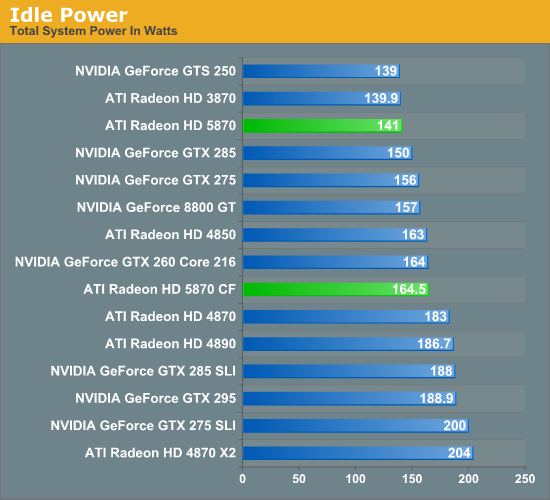
On our test bench, the idle power load of the system comes in at 141W, a good 42W lower than either the 4870 or 4890. The difference is even more pronounced when compared to the multi-GPU cards that the 5870 competes with performance wise, with the gap opening up to as much as 63W when compared to the 4870X2. In fact the only cards that the 5870 can’t beat are some of the slowest cards we have: the GTS 250 and the Radeon HD 3870.
As for the 5870 CF, we see AMD’s CF-specific power savings in play here. They told us they can get the second card down to 20W, and on our rig the power consumption of adding a second card is 23.5W, which after taking power inefficiencies into account is right on the dot.
Moving on to load power, we are using the latest version of the OCCT stress testing tool, as we have found that it creates the largest load out of any of the games and programs we have. As we stated in our look at Cypress’ power capabilities, OCCT is being actively throttled by AMD’s drivers on the 4000 and 3000 series hardware. So while this is the largest load we can generate on those cards, it’s not quite the largest load they could ever experience. For the 5000 series, any throttling would be done by the GPU’s own sensors, and only if the VRMs start to overload.
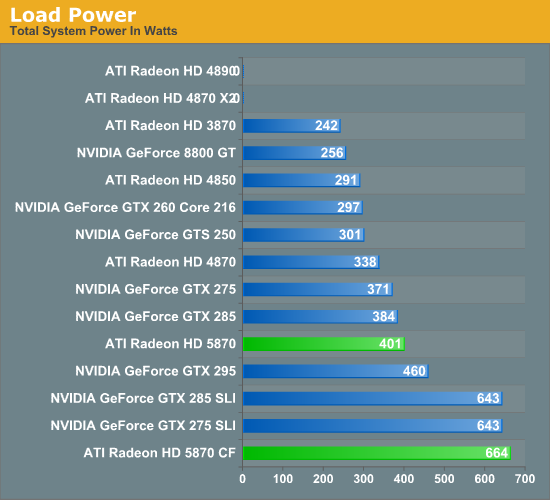
In spite of AMD’s throttling of the 4000 series, right off the bat we have two failures. Our 4870X2 and 4890 both crash the moment OCCT starts. If you ever wanted proof as to why AMD needed to move to hardware based overcurrent protection, you will get no better example of that than here.
For the cards that don’t fail the test, the 5870 ends up being the most power-hungry single-GPU card, at 401W total system power. This puts it slightly ahead of the GTX 285, and well, well behind any of the dual-GPU cards or configurations we are testing. Meanwhile the 5870 CF takes the cake, beating every other configuration for a load power of 664W. If we haven’t mentioned this already we will now: if you want to run multiple 5870s, you’re going to need a good power supply.
Ultimately with the throttling of OCCT it’s difficult to make accurate predictions about all possible cases. But from our tests with it, it looks like it’s fair to say that the 5870 has the capability to be a slightly bigger power hog than any previous single-GPU card.
In light of our results with OCCT, we have also taken load power results for our suite of cards when running World of Warcraft. As it’s not a stress-tester it should produce results more in line with what power consumption will look like with a regular game.

Right off the bat, system power consumption is significantly lower. The biggest power hogs are the are the GTX 285 and GTX 285 SLI for single and dual-GPU configurations respectively. The bulk of the lineup is the same in terms of what cards consume more power, but the 5870 has moved down the ladder, coming in behind the GTX 275 and ahead of the 4870.
Next up we have card temperatures, measured using the on-board sensors of the card. With a good cooler, lower idle power consumption should lead to lower idle temperatures.
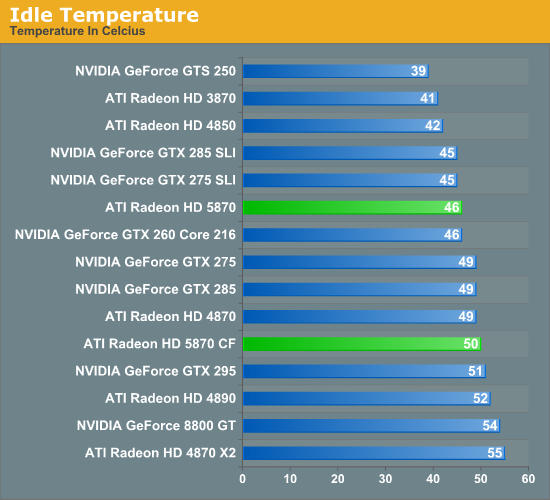
The floor for a good cooler looks to be about 40C, with the GTS 250, 3870, and 4850 all turning in temperatures around here. For the 5870, it comes in at 46C, which is enough to beat the 4870 and the NVIDIA GTX lineup.
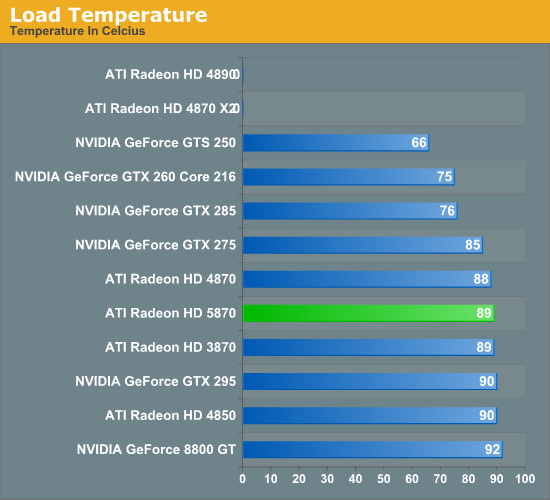
Unlike power consumption, load temperatures are all over the place. All of the AMD cards approach 90C, while NVIDIA’s cards are between 92C for an old 8800GT, and a relatively chilly 75C for the GTX 260. As far as the 5870 is concerned, this is solid proof that the half-slot exhaust vent isn’t going to cause any issues with cooling.
Finally we have fan noise, as measured 6” from the card. The noise floor for our setup is 40.4 dB.

All of the cards, save the GTX 295, generate practically the same amount of noise when idling. Given the lower energy consumption of the 5870 when idling, we had been expecting it to end up a bit quieter, but this was not to be.
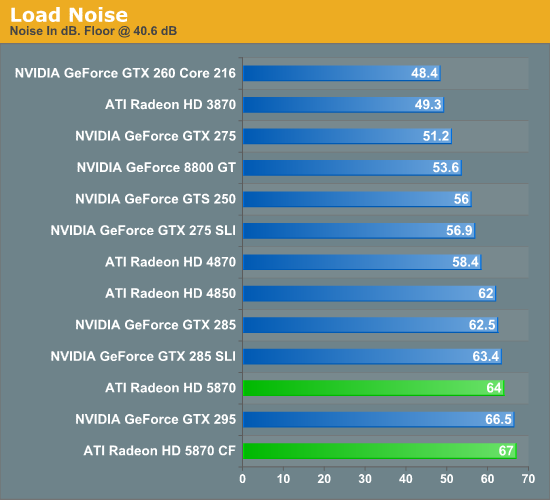
At load, the picture changes entirely. The more powerful the card the louder it tends to get, and the 5870 is no exception. At 64 dB it’s louder than everything other than the GTX 295 and a pair of 5870s. Hopefully this is something that the card manufacturers can improve on later on with custom coolers, as while 64 dB at 6" is not egregious it’s still an unwelcome increase in fan noise.










327 Comments
View All Comments
SiliconDoc - Sunday, September 27, 2009 - link
I'll be watching you for the very same conclusion when NVidia launches soft and paper.I'll bet ten thousand bucks you don't say it.
I'll bet a duplicate amount you're a red rager fan, otherwise YOU'D BE HONEST, NOT HOSTILE !
rennya - Thursday, September 24, 2009 - link
It may be paper-launch in the US, but here somewhere in South East Asia I can already grab a Powercolor 5870 1GB if I so desire. Powercolor is quite aggresive here promoting their ATI 5xxx wares just like Sapphire does when the 4xxx series comes out.SiliconDoc - Thursday, September 24, 2009 - link
I believe you. I've also seen various flavors of cards not available here in the USA, banned by the import export deals and global market and manufacturer and vendor controls and the powers that be, and it doesn't surprise me when it goes the other way.Congratulations on actually having a non fake launch.
Spoelie - Wednesday, September 23, 2009 - link
"The engine allows for complete hardware offload of all H.264, MPEG-2 and VC1 decoding".This has afaik never been true for any previous card of ATi, and I doubt it has been tested to be true this time as well.
I have detailed this problem several times before in the comment section and never got a reply, so I'll summarize: ATi's UVD only decodes level 4 AVC (i.e. bluray) streams, if you have a stream with >4 reference frames, you're out of luck. NVIDIA does not have this limitation.
lopri - Wednesday, September 23, 2009 - link
Yeah and my GTX 280 has to run full throttle (3D frequency) just to play a 720p content and temp climbs the same as if it were a 3D game. Yeah it can decode some *underground* clips from Japan, big deal. Oh and it does that for only H.264. No VC-1 love there. I am sure you'd think that is not a big deal, but the same applies to those funky clips with 13+ reference frames. Not a big deal. Especially when AMD can decode all 3 major codecs effortlessly (performance 2D frequency instead of 3D frequency)rennya - Thursday, September 24, 2009 - link
G98 GPUs (like 8400GS discrete or 9400 chipset) or GT220/G210 can also do MPEG2/VC-1/AVC video decoding.The GPU doesn't have to run full throttle either, as long as you stick to the 18x.xx drivers.
SJD - Wednesday, September 23, 2009 - link
Ryan,Great article, but there is an inconsistancy. You say that thanks to there only being 2 TDMS controllers, you can't use both DVI connectors at the same time as the HDMI output for three displays, but then go onto say later that you can use the DVI(x2), DP and HDMI in any combination to drive 3 displays. Which is correct?
Also, can you play HDCP protected content (a Blu-Ray disc for example) over a panel connected to a Display Port connector?
Otherwise, thanks for the review!
Ryan Smith - Wednesday, September 23, 2009 - link
It's the former that is correct: you can only drive two TDMS devices. The article has been corrected.And DP supports HDCP, so yes, protected content will play over DP.
SJD - Friday, September 25, 2009 - link
Thanks for clarifying that Ryan - It confirms what I thought.. :-)chowmanga - Wednesday, September 23, 2009 - link
I'd like to see a benchmark using an amd cpu. I think it was the Athlon II 620 article that pointed out how Nvidia hardware ran better on AMD cpus and AMD/ATI cards ran better on Intel cpus. It would be interesting to see if the 5870 stacks up against Nv's current gen with other setups.